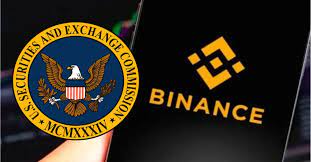Panorama of 1.49 million blockchain patents: BATJP accounts for 26%, and the game category welcomes a breakthrough
Analyst | Carol Editor | Bi Tongtong
Produced | PANews
On April 3, the central bank held a 2020 national telecom conference on currency, gold, silver and security work. The meeting called for strengthening the top-level design and unswervingly advancing the research and development of legal digital currencies. On April 10, Zhou Xuedong, director of the Central Bank's General Office, said at the first quarter financial statistics data conference that the digital currency is proceeding in an orderly manner as originally planned.
The central bank's digital currency has always been regarded as an important benefit by the blockchain industry. This news update not only boosted the A-share blockchain sector, but also once again aroused the market's attention to the development of blockchain technology. In order to show the current status and trends of technological development, PAData sorted out 14,900 public blockchain patents and comprehensively counted 10,400 blockchain patents published in China since 2019 (application number deduplication) to explore who is in Actively docking with the central bank's digital currency, who is accumulating blockchain technology strength quickly, and which direction is the most fierce in technological competition.
- ABC starts testing central bank digital currency, DCEP officially enters countdown
- Is Bitcoin going to be postponed? Atomic Loans completed $ 2.45 million in financing and developed the first non-custodial Bitcoin DeFi protocol
- Babbitt column | Decentralized trading, stablecoin, DeFi "love each other"

Over 14,900 patents have been published on blockchain
Tencent and Ali have the most public patents
According to statistics, China has so far applied for and published more than 14,900 blockchain patents.
Among them, 2018 was the year with the most applications for blockchain patents, with a total of 6,651 blockchain patents, an increase of 273.44% from the previous month. Although the number of applications declined in 2019, it reached 5,813, a decrease of approximately 12.60% from the previous month. However, in the more than three months that have passed in 2020, the number of blockchain patent applications is only 21, far below the monthly average of the previous two years, but this may be affected by the epidemic because of patent applications and examinations.
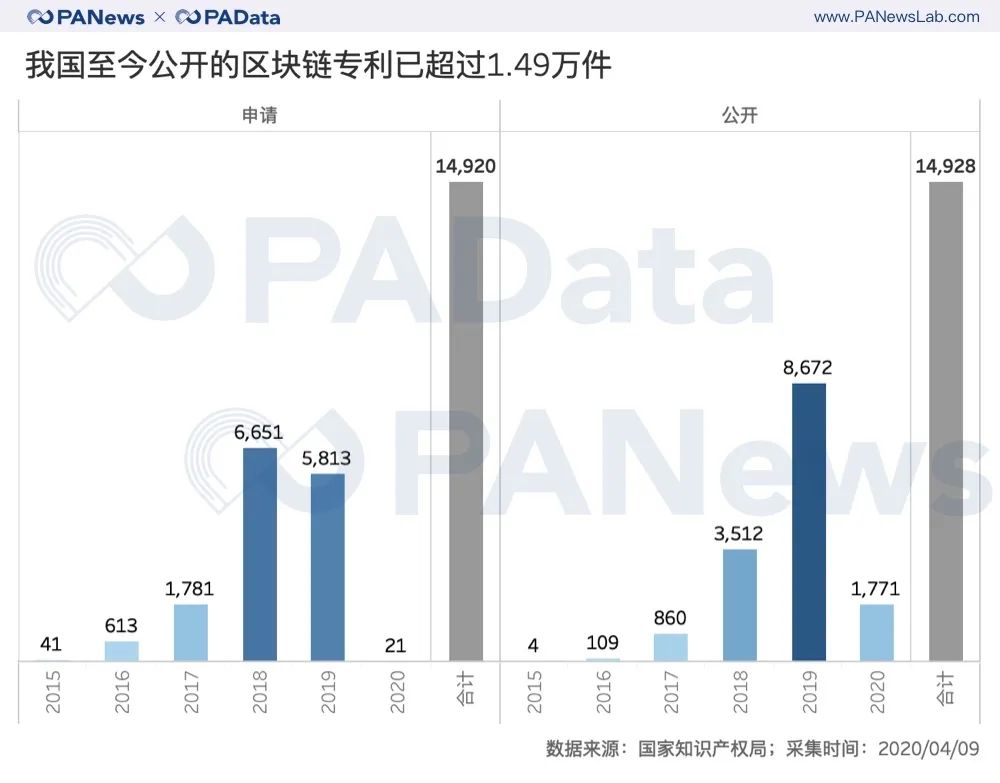
Among the published patents, they accounted for 58.09% in 2019, a total of 8672, up 30.39% from the previous month. Since 2020, 1,771 patents have been published, accounting for approximately 11.86%. According to the number of applications in 2019, this year's public volume may be close to last year's high level.
According to PAData's earlier analysis of blockchain patents, as of 2018, Alibaba was the company that disclosed the most blockchain patents, with a total of 86 disclosed. But a year later, whether it is the ranking of enterprises / institutions, or the number of blockchains disclosed by enterprises / institutions, great changes have taken place.
Since 2019, there have been 2,672 applicants (companies / universities / institutions or individuals) who have disclosed blockchain patents, and 19 applicants have disclosed more than 50 patents.
Among them, Tencent surpassed Alibaba to become the company with the most open blockchain patents, with a total of 776 disclosed. It is worth noting that before 2019, Tencent only published a total of 16 related patents. Tencent launched its blockchain technology in 2019, and topped the list of blockchain patents within a year.

Alibaba, the Internet giant that also launched blockchain technology in 2019, has published a total of 608 related patents, second only to Tencent. After Tencent and Alibaba, blockchain technology company Emorita is ranked third, and 306 blockchain patents have been published so far in 2019. Secondly, applicants with more than 100 open patents also include One Account, Ping An Technology, Zongmei, China Unicom, Netcore Technology (Thunder), Yuanzheng Technology, Baidu and FunChain.
Patent application, publication and authorization are three successive different stages. Although the number of blockchain patents disclosed in China is already considerable, the number of actually authorized blockchain patents is still quite small. According to the analysis of Zero One Finance, as of October 2019, the licensing rate of China's blockchain patents is 4.48%, far lower than AI, big data and other technologies. But in turn, the low authorization rate may be one of the reasons for the sharp increase in the number of blockchain patent publications, because there is no patent protection, and all applicants can still apply.

Patents are concentrated in the five major groups of BATJP
And the three major systems of universities, banks, and State Grid
In further observation of blockchain patent applicants, it can be found that these applicants have a strong group or systemic nature. If the applicants are classified by group investment / holding, or by the similarity of business operations / activities, you can see that the five major groups of Alibaba, Baidu, JD, Ping An, and Tencent hold a large number of related patents. In addition, State Grid, universities / research Colleges, banks and foreign companies also have more related patents.
According to incomplete statistics, there are a total of 32 companies that disclose blockchain patents under the five major groups of BATJP. Since 2019, a total of 2292 blockchain patents have been published, accounting for 26.43% of the total. Moreover, each group has published patents since 2019. More than 100, equivalent to TOP 10 in the number of patents entered.

Among them, in addition to the holding of Alibaba Group, Alipay has also disclosed 65 blockchain patents in the Alibaba system, involving application scenarios such as digital identity, medical treatment, certificate registration, and power confirmation. In addition to Tencent in the Tencent department, Tencent Cloud Computing and Tencent Music also disclosed 36 and 1 blockchain patents, respectively, involving data processing methods of blockchain transaction systems, alliance chain verification methods, and numerical transfer methods. The Ping An Department's business areas involving blockchain technology are more extensive, and 11 companies are involved in various fields including insurance, inclusive finance, electronic wallets, medical health, and urban construction.
In addition to BATJP, companies / universities in the four major categories of universities / research institutes, State Grid, banks, and foreign companies also disclose many blockchain technologies. Especially in the university / research system, 272 units have published 1,191 blockchain patents since 2019. Among them, Guangdong University of Technology is the school with the most open blockchain patents, a total of 54, followed by Xi'an University of Electronic Technology, Beijing University of Posts and Telecommunications, Nanjing University of Posts and Telecommunications and Beijing University of Aeronautics and Astronautics, all exceeding 30 related patents.

The number of blockchain patents disclosed by banks and foreign companies is relatively small. 17 banks have published a total of 191 blockchain patents. Among them, Wezhong Bank, ICBC, UnionPay, Bank of China and Agricultural Bank of China have disclosed more patents. 28 foreign companies have published a total of 161 blockchain patents. MasterCard, International Business Machines Corporation (IBM), Accenture, Nokia, Panasonic, Siemens and Intel have more patents.
In addition, what is more surprising is that many companies in the national grid system have published blockchain patents, and 49 units have published 123 related patents since 2019. The application scenarios involved are in addition to power-related In addition to tower monitoring system, power audit system, power grid data integrity monitoring system, power material management mechanism, etc., it also involves scenarios such as corporate financing risk control, node selection, and cascade authentication.

Gaming breakthrough
Significant increase in data processing
Similar to PAData's earlier analysis, the major categories of blockchain patent technology disclosed since 2019 are still mainly G06 ("calculation; extrapolation; counting") and H04 ("electrical communication technology"). Only the two categories have the largest number of There are 5581 and 3402 in the two subcategories G06Q and H04L (the same patent can belong to different patent subcategories, so the statistical number of subclass patents will be higher than the total).

However, from the perspective of the number of subclass patents, there is an important change in 2019, that is, the number of G06F data processing patents surpasses H04L digital information transmission patents to become the second most technical subclass of patents. The patents published by G06F from 2019 to the present have increased by 231.05% compared with 2018, which is the fastest growing category among all technical subcategories.
According to the interpretation of the sub-category of technology by the Patent Office of the State Intellectual Property Office and the classification of subordinates, G06F mainly contains data processing methods, such as algorithms, and also includes data input and output. H04L mainly includes protocol, key distribution, transmission control, identity authentication, etc. G06Q mainly includes payment agreements, financial derivatives or currency exchange, e-commerce, information retrieval and its database structure.
The change of technology sub-category means that since 2019, the development of blockchain technology is still mainly focused on the related fields of digital currency payment, but the research on the related fields of data processing has surpassed the related fields of the underlying technology.
The vast majority of blockchain patents are divided into G06Q subclasses by examiners, which may be a reason for the low final licensing rate of blockchain patents. Ji Jianxun revealed that G06Q belongs to the category of business method patents. This type of patent is more difficult to be authorized. Because the business method is theoretical, the application coverage is very wide, and the impact of authorized patents is relatively large, so the review will be more cautious.
In addition, from 2019 to 2018, blockchain technology has made breakthroughs in 6 subcategories. The most significant patent breakthrough comes from the A63F game patent, and the common game methods in game DApps, such as cards and dice, belong to this category. The number of such patents published in 2018 is still 0, and a total of 109 have been published so far in 2019.
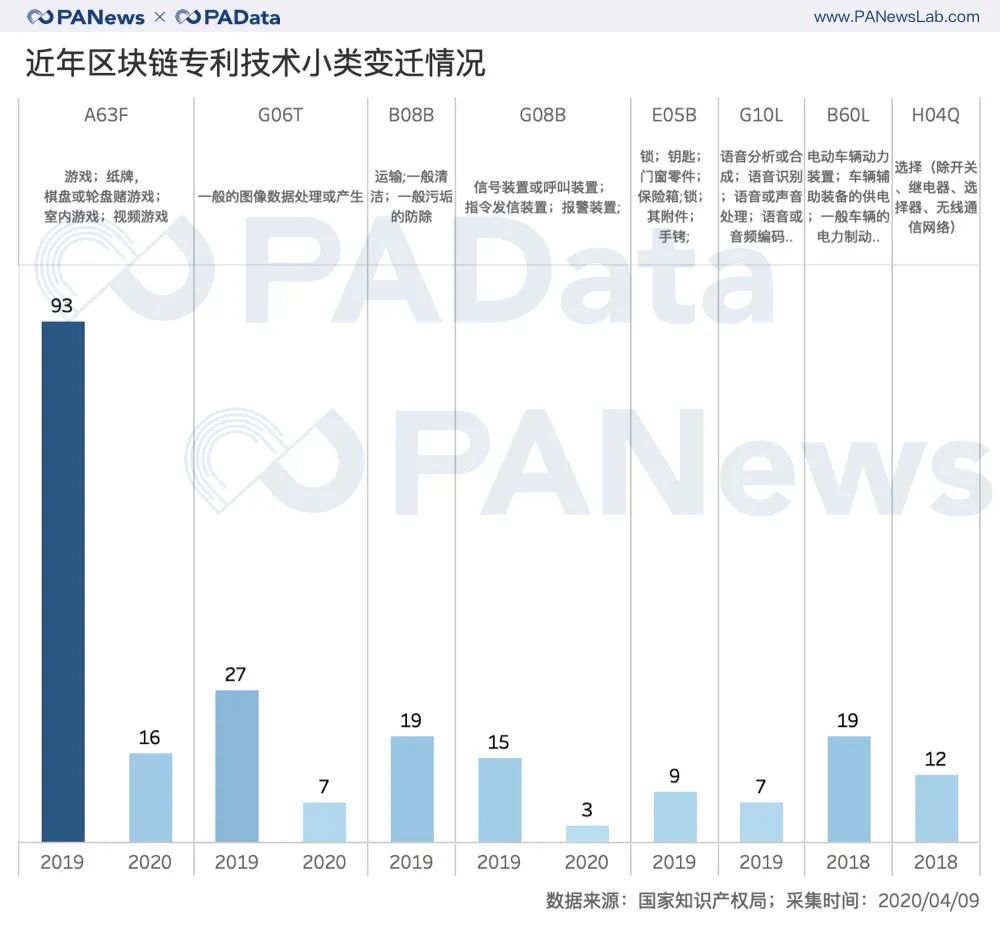
In addition, G06T image data processing or generation patents, B08B transportation patents, G08B signaling device patents, E05B locks; key patents and G10L voice analysis patents also broke through zero patents. In addition, the B06L electric vehicle device patents and the H04Q selection device patents have gone from there to no, and will no longer be developed after 2019.

Centralization of patent competition
Only 5 central bank blockchain patents disclosed
According to the applicant and the field of patent technology, in 2018, companies with more published patents still have room for differentiated layout. For example, Baidu has the only patent in the field of A63F games, ZhongAn has the only patent in the general image data processing or generation field of G06T, Alibaba has the only patent in the field of G10L speech analysis or synthesis, and so on.
But after a round of "patent blowout", few companies have a unique patent in a certain technical field after 2019. Only Blockchain Holdings Limited disclosed the only H04B transmission patent, and Ping An Technology released the second G10L voice analysis patent after Ali.
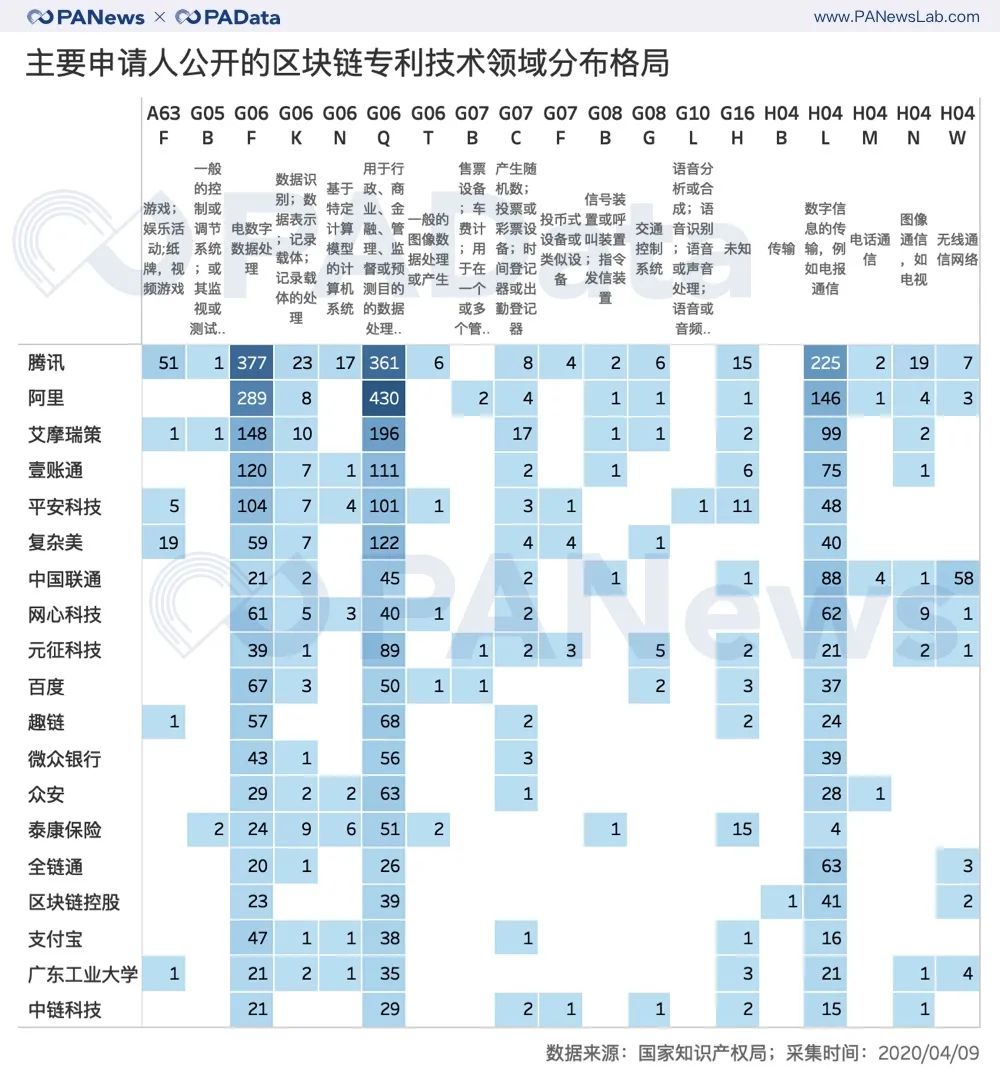
In addition, G05B general control or mediation transposition patents, G07B ticketing equipment or car billing patents, G08B signaling device patents, H04M telephone communication patents are all less than 10, and there are not all applicants with these types of patents. More than 6. The patents of other small categories basically cover most applicants, and the number is large, which creates a situation in which the competition for patent authorization is more concentrated.
In the financial field considered to be the most likely land for blockchain, the patents of various banks are mainly concentrated in the five categories of G06Q, G06F, H04L, G06K, and G07C, and most of them cover more than three of these categories.
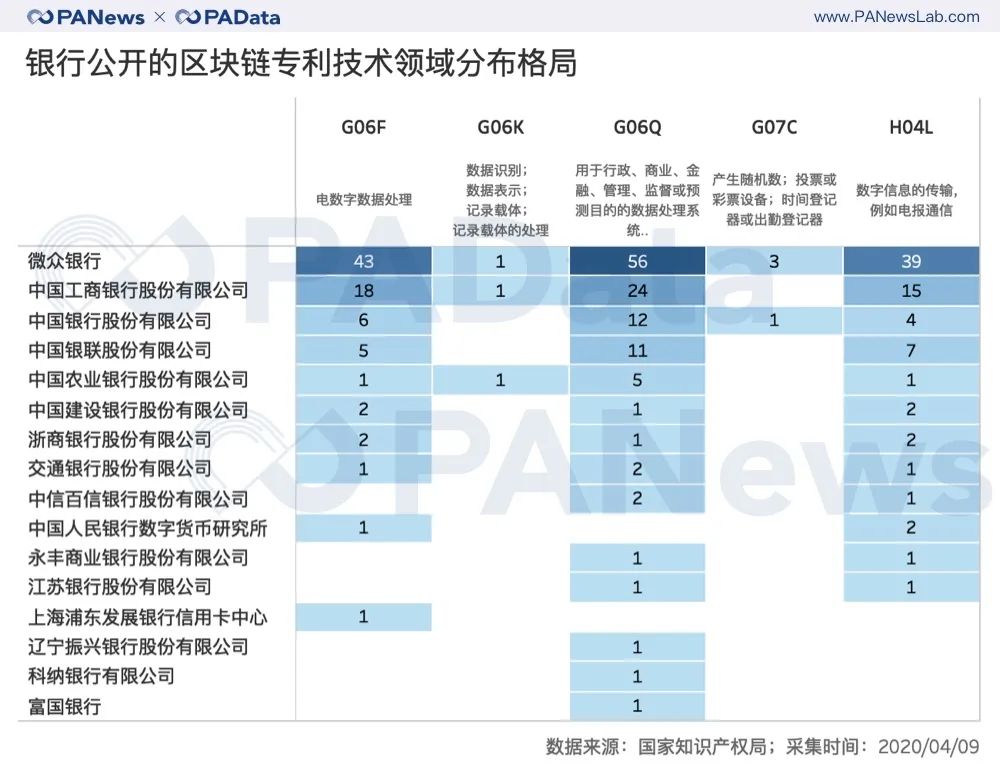
Of particular note is that the Digital Currency Research Institute of the People's Bank of China has only published 3 blockchain-related patents since 2019, and historically only 5 blockchain-related patents have been disclosed, accounting for only 76 published patents. 6.58%.
The two patents published so far in 2019 relate to the fields of H04L and G06F (one of which involves two fields, and the subclass statistics are 3 patents). The names of these two patents are "a method, device and system for file stream processing based on blockchain" and "a method, device and system for file authorization access based on blockchain". In January of this year, these two patents have been submitted for substantive examination before they can be officially authorized.
The Blockchain-related patents of the People's Bank Digital Currency Research Institute do not involve the largest number of G06Q fields, but this is the area where other banks have the largest number of published patents. It is not known whether there is room for possible cooperation.
Throughout 2019, although all walks of life are accumulating blockchain patents, whether the more patents the better, there are different voices in the industry. Wang Feng, chairman of Blueport Interactive, once posted on Weibo, “In terms of open source code for public chains, China ’s code contribution is only one-third of that in the United States, and more than 80% of the blockchain technology platforms of Chinese independent technology platform developers are Use foreign open source technologies, such as Fabric, Ethereum, etc. I hope not to deceive local governments with just the number of so-called patent applications. "
The number of open blockchain patents second only to Tencent and Ali's CTO Ji Jianxun once said, "Now the industry is still in the early stages, there are many scenarios that require technological breakthroughs, and most companies apply for patents in hopes of passing Patent protection technology. This kind of protection is not premised on profit. It is difficult for software companies to make profits through patents. Generally, communication companies or hardware companies make more profits through patents to promote international standards. "
the data shows:
[1] This statistical caliber is for patents containing "Blockchain" in the published text included in the Patent Search and Analysis Database of the Patent Office of the State Intellectual Property Office from January 1, 2019 to April 9, 2020. A total of 10,400 patents were obtained after the number was removed.
We will continue to update Blocking; if you have any questions or suggestions, please contact us!
Was this article helpful?
93 out of 132 found this helpful
Related articles
- What is the suggestion of the 130,000-word blockchain report of the Mutual Gold Association for the application in the financial field?
- The nation's first provincial-level blockchain application innovation industry alliance was established in Chongqing
- Research | The Value Capturer after the Fat Protocol Era——Middleware Protocol
- Inspiration of stablecoins: analysis of the "Black Thursday" crisis and construction of a new borrowing and buffering model
- Bitcoin as ransom, WannaRen ransomware hits twice
- "Digging" 500 years to recover the cost of equipment? V God calls HTC mobile mining a fool's game
- Learn about Utreexo, an improved MIT Bitcoin solution in 5 minutes


